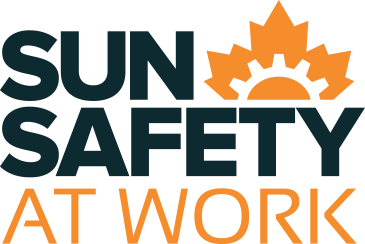If you or your employees work outdoors, you are exposed to the sun. The sun is a workplace hazard that causes the following:
- Health conditions of the skin and eye from over-exposure to solar ultraviolet (UV) radiation, including skin cancer, sunburn, and cataracts, among others.
- Heat stress caused by exposure to the sun
Sun safety is what workplaces do to manage sun exposure.
How dangerous is the sun for outdoor workers?
For outdoor workers, sun exposure is the primary source of skin cancer1 and heat stress2. Outdoor workers are at a higher risk of both conditions. They often have more sun exposure than the workplace exposure limits.3
Between 1.5 million4 and 5.4 million5 Canadians are exposed to the sun on the job. Of these workers, about 67% spend two or more working hours in the sun every work day.6
Outdoor workers have up to a 3.5 times greater risk of developing skin cancer than indoor workers.7 Eye damage from long term exposure to the sun is also a concern, and heat stress is another major issue for outdoor workers.
The good news is that skin cancer, eye damage from the sun, and heat stress are preventable.
How can workplaces and workers be more sun safe?
Workers and workplaces both have a role in workplace sun safety. Workplaces can be more sun safe by implementing a sun safety program. Workers can follow six simple steps to protect themselves from both solar UV radiation and heat from the sun.
Off-the-job sun safety
Sun safety does not only apply at work. It is important to be sun safe off-the-job as well. Many outdoor workers also spend a lot of recreational time outdoors.8 This means sun safety on and off the job are key to preventing skin cancer, eye damage, and heat stress. Tips for off-the-job sun safety include to:
- Protect yourself and your family:
- Be a good role model for your family and practice sun safety.
- Remember that children are more vulnerable to sunburn and skin damage, and skin damage early in life increases the risk of skin cancer.9
- Visit your health professional regularly for skin exams
- Check your skin regularly for skin cancer or sun damage
- 1. Elwood, J. M. (2004). Who gets skin cancer: individual risk factors. In DJ Hill, JM Elwood, and DR English (Eds.), Prevention of Skin Cancer (pp. 3-20). Dordrecht: Kluwer.
- 2. Ontario Ministry of Labour. (2014, June). Heat stress. Retrieved from http://www.labour.gov.on.ca/english/hs/pubs/gl_heat.php
- 3. Peters, C. E., Nicol, A. M., Demers, P. A. (2012). Prevalence of exposure to solar ultraviolet radiation (UVR) on the job in Canada. Can J Public Health, 103(3), 223-226.
- 4. Peters, Nicol, Demers, 2012.
- 5. Marrett, L. D., Pichora, E. C., Costa, M.L. (2010). Work-time sun behaviours among Canadian outdoor workers: results from the 2006 National Sun Survey. Can J Public Health, 101(4), 119-122.
- 6. Peters, Nicol, Demers, 2012.
- 7. Radespiel-Tröger, M., Meyer, M., Pfahlberg, A., Lausen, B., Uter, W., Gefeller, O. (2009). Outdoor work and skin cancer incidence: a registry-based study in Bavaria. Int Arch Occup Environ Health, 82, 357–36.
- 8. Marrett, Pichora, Costa, 2010.
- 9. Hornung, R.L. (2000). Sun Protection in Children. Current Problems in Dermatology, 12(4), 194-197.

